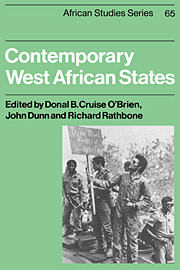10 - Sierra Leone
State consolidation, fragmentation and decay
Published online by Cambridge University Press: 10 December 2009
Summary
The development of the state in Sierra Leone during the 1970s and 1980s has been marked by contradiction and crisis. On the one hand, we have witnessed the centralisation of state power, the personalisation of authority, and the extension of state control into most sectors of society. This process has been paralleled by a steady growth in the size of the state, which has become the largest employer in the nation and which has come to be held responsible for the country's economic health. On the other hand, we have observed an overall weakening of state institutions, the development of powerful autonomous political and economic spheres of influence, and the fragmentation of political structures that had guaranteed its hegemony and assured legitimacy in an earlier era. State decline has been intensified by failures in government performance, escalating corruption and the incapacity of the state to generate sufficient revenue to meet its rapidly expanding budgetary requirements.
As competition for power and scarce resources grew more acute during the 1970s and 1980s, the incumbent APC (All People's Congress) political elite tried to limit political competition. The centralisation of power in the hands of President Siaka Stevens also continued unabated. In the process, inequities and public dissatisfaction increased. The response of the ruling elite to demands for accountability was the routinisation of manipulation and coercion.
- Type
- Chapter
- Information
- Contemporary West African States , pp. 165 - 180Publisher: Cambridge University PressPrint publication year: 1990
- 1
- Cited by

